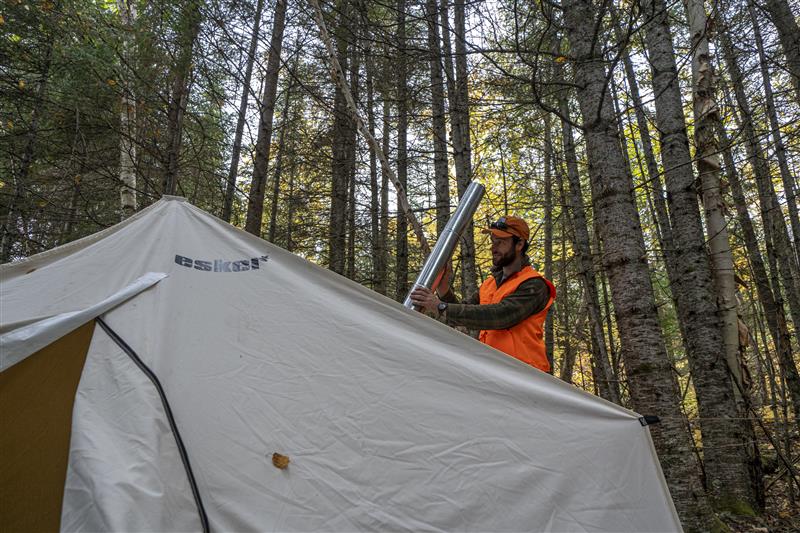How We Camp: A Winter Journey Across Canada
How We Camp: A Winter Journey Across Canada
Across Canada, the leaves are changing colours and the warm weather gives way to winter. Canadians from coast to coast now turn to winter activities to enjoy the beauty of this land. From the windswept coasts of the Maritimes to the frozen boreal of the Shield, from mountain passes to the northern tundra, winter camping takes on a thousand forms. Each landscape brings its own unique challenges and breathtaking beauty.
Understanding the environment ensures a safe and comfortable experience. Below are key factors to consider when planning your next trip.
Maritimes (NS, NB, PEI)
• Peak Season for Winter Hot Tent Camping: January–February
• Average Temperatures: –5 °C to –10 °C (day), –15 °C to –20 °C (night)
• Common Modes of Travel: Snowmobile, snowshoe, pulk sled.
• Wood Available for Stove: Maple, birch (main); oak, ash (less common); poplar, aspen, spruce (kindling); softwoods mainly for kindling.
• Tent Features Needed: Double-zippered entrance, adjustable vent, lightweight design and compact packability for easy transport.
• Flooring: Evergreen boughs for snowmelt management.
• Additional Gear to Pack: Layered insulated sleeping system, parka, mitts, gaiters, shovels, fire starters, dry kindling, backup compact stove with fuel, cot or mat to keep the body off the floor.
Canadian Shield (Northern ON, QC, MB)
• Peak Season for Winter Hot Tent Camping: December–February
• Average Temperatures: –10 °C to –15 °C (day), –25 °C (night)
• Common Modes of Travel: Snowshoe, pulk sled, snowmobile.
• Wood Available for Stove: Birch (paper birch), maple (sugar/red), oak (limited), softwoods for kindling.
• Tent Features Needed: Double-zippered entrance, adjustable vent, lightweight design and compact packability for easy transport.
• Additional Gear to Pack: Layered insulated sleeping system, parka, mitts, gaiters, shovels, fire starters, dry kindling, backup compact stove with fuel, cot or mat to keep the body off the floor.
Coastal British Columbia
After the frozen forests of the Shield, the landscape changes again as you move west. Coastal British Columbia offers a different kind of winter: milder temperatures, frequent rain and mist, and dense evergreen forests where snow is less persistent. Here, warmth and dryness become the true luxuries of the trail.
• Peak Season for Winter Hot Tent Camping: December–March
• Average Temperatures: 0 °C to +5 °C (day), –5 °C to 0 °C (night)
• Common Modes of Travel: Hike, snowshoe, canoe (in mild coastal areas.)
• Conditions: High humidity, frequent rain or wet snow, and limited freeze–thaw cycles make moisture management a constant consideration. Canvas hot tents and stoves can still be used, but only with experience and care; prolonged exposure to damp conditions may affect performance and longevity. Some campers choose to pitch a tarp above the tent to shed excess rain, which can help protect the canvas without compromising airflow.
• Wood Available for Stove: Western red cedar, hemlock, Douglas fir; softwoods for kindling, seasoned hardwoods for heat. Note that in some coastal areas, large dry boughs are less readily sourced than in snow-covered forests, making careful planning essential.
• Tent Features Needed: Double-zippered entrance, adjustable vent, lightweight design and compact packability for easy transport.
• Additional Gear to Pack: Waterproof boots, layered clothing, ventilation aids for the tent, backup compact stove with fuel, rain tarp.
In coastal conditions, the focus shifts from building a deep snow campsite to managing dampness and airflow. Only campers who understand these challenges will find a canvas hot tent and stove a reliable option; careful preparation and mindful site selection are essential to a safe and comfortable experience.
Western Mountains (Interior BC, AB Rockies)
• Peak Season for Winter Hot Tent Camping: January–March
• Average Temperatures: 0 °C (day), –20 °C (night); wind increases chill.
• Common Modes of Travel: Ski, snowshoe, snowmobile.
• Optimal Site Selection: Use windbreaks, avoid ridges, avalanche paths, steep slopes, and dead trees; camp on packed snow at least 200 ft from water and trails.
• Tent Features Needed: Double-zippered entrance, adjustable vent, lightweight design and compact packability for easy transport.
• Wood Available for Stove: Douglas fir, tamarack, lodgepole pine, birch; softwoods for kindling, hardwoods for heat.
• Additional Gear to Pack: Layered insulated sleeping system, parka, mitts, gaiters, shovels, avalanche probes, fire starters, dry kindling, backup compact stove with fuel, cot or mat to keep the body off the floor.
Northern Territories (Yukon, NWT, Nunavut)
• Peak Season for Winter Hot Tent Camping: December–February (early March for longer daylight.)
• Average Temperatures: Can drop below –40 °C.
• Common Modes of Travel: Snowmobile, sled, ski.
• Routes: Frozen rivers and tundra; follow traplines or Indigenous routes.
• Wood Available for Stove: White spruce, black spruce, tamarack, poplar, birch.
• Tent Features Needed: Double-zippered entrance, adjustable vent, lightweight design and compact packability for easy transport.
• Additional Gear to Pack: Layered insulated sleeping system, parka, mitts, gaiters, shovels, fire starters, dry kindling, backup stove with fuel, cot or mat to keep the body off the floor.
Final Thoughts
When sourcing wood from your surroundings, harvest a few boughs from various trees rather than many from a single tree. Always try to leave a few pieces of dry wood and kindling in used campsites for the next campers. Be mindful when chopping trees and gather only what you need. Practices like these help ensure our beautiful Canadian landscape can continue to be enjoyed with minimal impact for generations to come.
Canada’s winter landscapes are as diverse as they are beautiful, from the windswept coasts of the Maritimes to the frozen expanses of the North and the rugged peaks of the Rockies. Generations before us have traveled these lands, following traplines, Indigenous routes, and traditional paths that connect us to the wilderness and its rhythms. By planning our trips thoughtfully, respecting safety, and practicing sustainable camping, we can continue to explore and enjoy these landscapes while leaving them intact for those who come after us.








